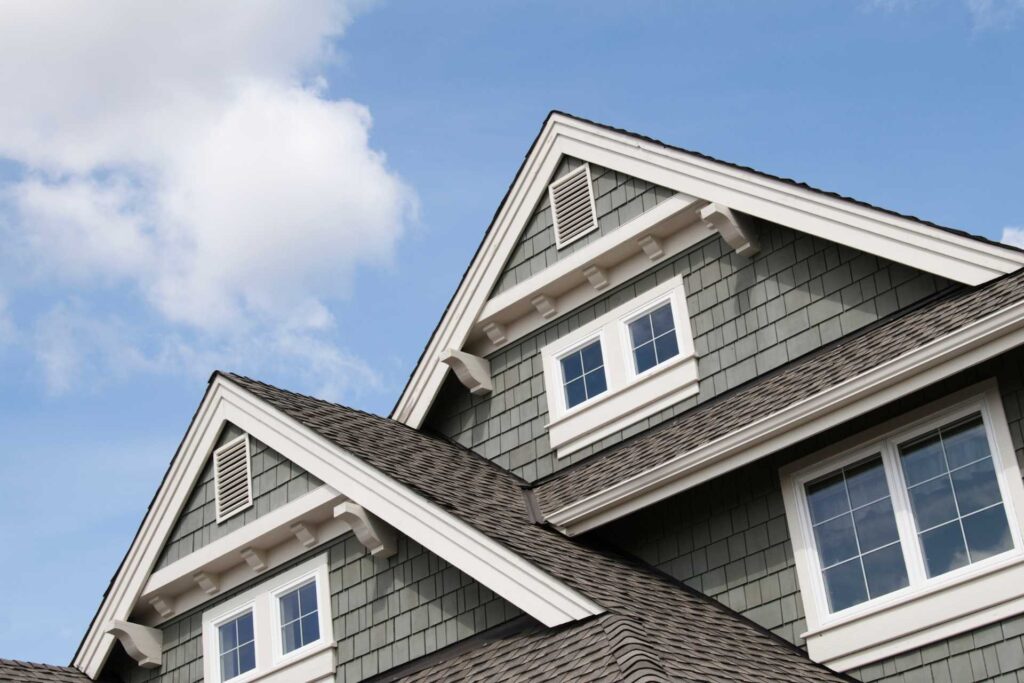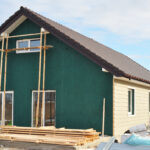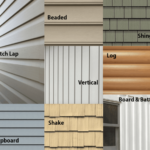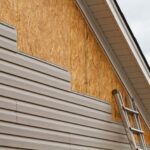Exploring the environmental impact of various siding materials, including their manufacturing process and disposal options, reveals a complex interplay of resource consumption, waste generation, and long-term environmental consequences. This analysis delves into the life cycle of three common siding materials – vinyl, wood, and fiber cement – examining their production processes, embodied carbon footprints, and end-of-life management. By comparing their environmental performance across these key stages, we aim to provide a comprehensive understanding of the sustainability implications of each choice, empowering informed decision-making for both homeowners and industry professionals.
The study meticulously investigates the energy intensity and waste generation associated with the manufacturing of each siding type. It also evaluates the embodied carbon throughout the entire life cycle, considering factors like transportation and raw material extraction. Furthermore, it explores the environmental consequences of different disposal methods, highlighting the importance of responsible end-of-life management practices such as recycling and reuse programs. The goal is to illuminate the relative environmental advantages and disadvantages of each material, providing a clear basis for making responsible and sustainable choices.
Manufacturing Processes of Siding Materials
The manufacturing processes of various siding materials significantly impact the environment, from resource extraction to waste generation and greenhouse gas emissions. Understanding these processes is crucial for making informed choices about sustainable building practices. This section details the manufacturing of vinyl, wood, and fiber cement siding, highlighting key environmental considerations.
Vinyl Siding Manufacturing
Vinyl siding production involves the polymerization of polyvinyl chloride (PVC) resin, a process that is energy-intensive. The resin is mixed with additives to enhance properties like color, flexibility, and impact resistance. This mixture is then extruded into long profiles, cut to length, and embossed to mimic the appearance of wood or other materials. The energy consumption is considerable, primarily due to the high temperatures required for the extrusion process. Waste generation stems from the trimming and cutting of the extruded profiles, as well as the handling and disposal of defective products. Further environmental concerns arise from the potential release of volatile organic compounds (VOCs) during manufacturing and the long lifespan and difficulty of recycling the final product.
Wood Siding Manufacturing
Wood siding production begins with the harvesting of trees, which can lead to deforestation and habitat loss if not managed sustainably. The harvested logs are then transported to mills where they are processed into lumber. This process involves debarking, sawing, drying (often in energy-intensive kilns), and planing. The environmental impacts are multifaceted and include the depletion of forest resources, the release of greenhouse gases during logging and processing, and the generation of wood waste (sawdust, bark, etc.). Sustainable forestry practices, such as selective logging and reforestation, can mitigate some of these impacts, but remain a significant challenge.
Fiber Cement Siding Manufacturing
Fiber cement siding is a composite material made from a mixture of Portland cement, cellulose fibers, and silica sand. The manufacturing process involves mixing these ingredients with water, forming the mixture into sheets or panels, and curing them under pressure and controlled temperature and humidity. The cement component contributes significantly to the carbon footprint of fiber cement siding, as cement production is a major source of CO2 emissions. Energy is also consumed during the mixing, forming, curing, and cutting processes. Waste generation is relatively lower compared to vinyl siding, mainly consisting of offcuts and imperfect panels. However, the disposal of fiber cement siding can pose challenges, as it is not easily recyclable.
Comparison of Siding Manufacturing Processes
| Material | Energy Use | Waste | Greenhouse Gas Emissions |
|---|---|---|---|
| Vinyl | High, due to extrusion and polymerization | Moderate, from trimming and defective products | Moderate to High, from PVC production and energy consumption |
| Wood | Moderate to High, depending on drying methods and transportation | High, from sawdust, bark, and offcuts | Moderate to High, depending on forestry practices and transportation |
| Fiber Cement | Moderate, primarily from cement production and curing | Low, mainly offcuts and imperfect panels | Moderate to High, primarily from cement production |
Embodied Carbon in Siding Materials
Understanding the embodied carbon in siding materials is crucial for evaluating their overall environmental impact. Embodied carbon refers to the greenhouse gas emissions generated throughout a material’s entire lifecycle, from raw material extraction and manufacturing to transportation, installation, and ultimately, disposal. This analysis focuses on vinyl, wood, and fiber cement siding, comparing their relative carbon footprints.
Embodied Carbon Breakdown by Material
The embodied carbon of siding varies significantly depending on the material. Vinyl siding generally exhibits a relatively high embodied carbon footprint due to the energy-intensive manufacturing process involving petroleum-based plastics. Wood siding, while a renewable resource, still carries an embodied carbon load associated with harvesting, processing, and transportation. Fiber cement siding, a composite material, presents a more complex picture, with its carbon footprint influenced by the cement component’s high energy demand and the use of wood fibers. Precise figures vary based on specific manufacturing processes and sourcing, but generally, vinyl tends to have the highest embodied carbon, followed by fiber cement, with wood often showing the lowest, particularly if sourced sustainably and locally.
Transportation and Logistics’ Contribution to Carbon Footprint
Transportation and logistics play a significant role in the overall carbon footprint of siding materials. The distance materials travel from manufacturing facilities to construction sites contributes substantially to emissions, particularly for heavier materials like fiber cement. Vinyl siding, often manufactured in large quantities at centralized facilities, may have a higher transportation impact due to the sheer volume shipped. Wood siding sourced locally can minimize transportation emissions, especially when compared to materials requiring long-distance shipping. Efficient logistics and transportation strategies, such as using rail transport where feasible or optimizing delivery routes, are crucial for reducing the environmental impact of each material.
Visualization of Relative Embodied Carbon
A bar graph effectively illustrates the relative embodied carbon of these siding materials. The horizontal axis would list the three materials: Vinyl, Wood, and Fiber Cement. The vertical axis would represent embodied carbon measured in kilograms of CO2e (carbon dioxide equivalent) per square meter of siding. The bars would visually represent the quantified embodied carbon for each material, with vinyl’s bar extending the highest, reflecting its larger carbon footprint, followed by fiber cement, and then wood exhibiting the shortest bar. A key would clarify the units (kg CO2e/m²) and possibly include a note about the variability of these figures based on factors like manufacturing practices and sourcing. For example, a sustainable wood sourcing scenario could be indicated with a smaller, separate bar next to the main wood bar to illustrate the potential for reduction through sustainable practices. The graph would clearly show the relative differences in embodied carbon among the three materials, providing a visual comparison readily understood by stakeholders.
Environmental Impact of Disposal
The end-of-life management of siding materials significantly impacts the environment. Disposal options vary depending on the material type, and each carries unique environmental consequences related to landfill space consumption, potential leaching of harmful substances, and greenhouse gas emissions. Understanding these impacts is crucial for developing sustainable strategies for siding material management.
Disposal Options and Environmental Consequences of Vinyl Siding
Vinyl siding, primarily composed of polyvinyl chloride (PVC), is not readily biodegradable and poses challenges for disposal. Landfilling is the most common method, contributing to landfill volume and potentially releasing harmful chemicals through leaching if the landfill isn’t properly managed. While some vinyl recycling programs exist, they are limited in scope and often require specialized processing. Incineration is another option, but this releases harmful air pollutants. The high embodied carbon of PVC production further compounds the environmental burden of vinyl siding throughout its entire lifecycle. For example, a study by the University of California, Berkeley, found that PVC production contributes significantly to greenhouse gas emissions.
Disposal Options and Environmental Consequences of Wood Siding
Wood siding, a more naturally derived material, offers better disposal options than vinyl. It can be landfilled, but this still contributes to landfill space issues. However, wood is biodegradable, meaning it will eventually decompose in a landfill, although this process is slow and can release methane, a potent greenhouse gas. Depending on the type of wood and its treatment, the decomposition process can also release other chemicals. Reuse and repurposing are viable options, as wood siding can be salvaged and used in other applications. In some cases, wood siding can even be ground down and used as mulch or biomass fuel. Proper disposal, involving separating treated lumber from untreated, is important to minimize environmental impact.
Disposal Options and Environmental Consequences of Fiber Cement Siding
Fiber cement siding, a composite material containing cement, cellulose fibers, and other additives, presents a more complex disposal scenario. Landfilling is the primary method, contributing to landfill volume. While fiber cement itself is relatively inert and doesn’t readily leach harmful chemicals, the additives used in its manufacture might. Recycling options for fiber cement siding are limited, and its large size makes it less suitable for direct reuse or repurposing. However, some components, like the cellulose fibers, could potentially be recovered and reused in other applications with further research and development of recycling technologies. The manufacturing process of fiber cement siding generates less greenhouse gas emissions compared to vinyl, reducing the overall environmental footprint, but landfill disposal remains a concern.
Strategies for Improving End-of-Life Management of Siding Materials
Improving the end-of-life management of siding materials requires a multi-pronged approach. Promoting reuse and repurposing through initiatives such as salvage yards and deconstruction projects can significantly reduce landfill waste. Investing in research and development to improve recycling technologies for vinyl and fiber cement siding is crucial. The implementation of extended producer responsibility (EPR) programs, where manufacturers share responsibility for the end-of-life management of their products, could incentivize the development of more sustainable materials and disposal solutions. Additionally, raising public awareness about the environmental impacts of different siding materials and promoting sustainable choices can drive positive change in the building industry.
Life Cycle Assessment of Siding Materials
A Life Cycle Assessment (LCA) provides a comprehensive framework for evaluating the environmental impacts of a product throughout its entire lifespan, from raw material extraction to end-of-life disposal. By comparing the LCA results for vinyl, wood, and fiber cement siding, we can gain valuable insights into their relative environmental performance and inform more sustainable building material choices.
LCA Framework for Siding Materials
This LCA framework considers three distinct phases: material extraction and manufacturing, product use, and end-of-life management. Each phase encompasses various environmental impacts that will be assessed using key indicators. The framework uses a cradle-to-grave approach, acknowledging the full environmental burden associated with each siding material. Data for the assessment will be drawn from peer-reviewed studies, industry reports, and manufacturer specifications, striving for a transparent and reproducible methodology.
Key Environmental Indicators
Several key environmental indicators are crucial for a comprehensive LCA of siding materials. These indicators provide a quantitative measure of the environmental burden associated with each material’s life cycle. These indicators are not exhaustive, but represent a core set for comparative analysis.
- Global Warming Potential (GWP): Measured in kilograms of carbon dioxide equivalent (CO2e), GWP quantifies the contribution of greenhouse gas emissions to climate change. This includes emissions from manufacturing, transportation, and disposal.
- Resource Depletion: This indicator assesses the consumption of non-renewable resources (e.g., fossil fuels) and the impact on the depletion of natural resources (e.g., timber). It may be expressed in terms of energy consumption or material extraction quantities.
- Eutrophication Potential: This indicator measures the contribution of nutrients (e.g., nitrogen and phosphorus) to excessive algal growth in water bodies, leading to oxygen depletion and harming aquatic ecosystems. It’s particularly relevant for materials with fertilizers or chemical treatments during manufacturing or installation.
- Acidification Potential: This measures the release of acidic compounds that contribute to acid rain and soil acidification. This is relevant for materials that release sulfur oxides or nitrogen oxides during their lifecycle.
- Ozone Depletion Potential (ODP): This assesses the contribution to the depletion of the stratospheric ozone layer, primarily relevant for materials containing ozone-depleting substances (ODS). While less relevant for common siding materials today, historical usage should still be considered.
LCA Evaluation of Siding Materials
The LCA framework will be applied to vinyl, wood, and fiber cement siding, considering each material’s specific characteristics. For example, the manufacturing of vinyl siding is energy-intensive and relies heavily on fossil fuels, contributing significantly to GWP and resource depletion. Wood siding, while a renewable resource, involves harvesting, transportation, and potential deforestation impacts, affecting resource depletion and potentially biodiversity. Fiber cement siding, although less energy-intensive than vinyl, requires the mining of raw materials and the use of cement, which has its own environmental implications including GWP and resource depletion. A comparative analysis will highlight the relative strengths and weaknesses of each material across all chosen environmental indicators. For instance, a study by the University of California, Berkeley, compared the life cycle impacts of different building materials and found significant variations in GWP and resource depletion across different materials, including various types of siding. Such studies provide valuable data points for the LCA framework. This data will be used to create a comparative matrix illustrating the environmental performance of each siding material across the various life cycle stages and key indicators. This matrix will allow for a direct comparison of the relative environmental impacts of each siding material, supporting informed decision-making in the selection of sustainable building materials.
Sustainable Sourcing and Manufacturing Practices
Minimizing the environmental footprint of siding materials extends beyond simply choosing a specific material; it necessitates a comprehensive approach encompassing sustainable sourcing and manufacturing processes. This section delves into the specific practices employed to lessen the impact of various siding options throughout their lifecycle.
Sustainable sourcing and manufacturing practices are crucial for reducing the environmental impact of siding materials. These practices aim to minimize resource depletion, pollution, and waste generation throughout the entire production process, from raw material extraction to final product disposal. By implementing responsible practices, manufacturers can significantly reduce the embodied carbon and overall environmental burden associated with siding.
Sustainable Sourcing of Wood Siding
Responsible forestry management is paramount for ensuring the long-term sustainability of wood siding. This includes practices like selective logging, which minimizes damage to the surrounding ecosystem, and reforestation efforts to replace harvested trees. Furthermore, certification schemes, such as the Forest Stewardship Council (FSC) certification, provide assurance that the wood used originates from responsibly managed forests that meet stringent environmental and social standards. FSC certification verifies that the wood has been harvested in a manner that maintains biodiversity, protects soil and water resources, and respects the rights of workers and local communities. Companies committed to sustainability often prioritize sourcing wood with this certification.
Reducing the Environmental Impact of Vinyl and Fiber Cement Siding Production
Manufacturers can significantly reduce the environmental impact of vinyl siding production through process improvements focused on energy efficiency and waste reduction. This includes implementing cleaner production technologies that minimize the release of volatile organic compounds (VOCs) and other harmful pollutants. Recycling post-consumer PVC waste into new vinyl siding products can also help reduce reliance on virgin materials. For fiber cement siding, manufacturers can reduce their environmental footprint by using alternative cementitious binders with lower embodied carbon and incorporating recycled materials such as fly ash or slag into the mix. Optimizing the manufacturing process to reduce energy consumption and waste generation further minimizes environmental impact. For instance, a manufacturer might invest in energy-efficient kilns to reduce their carbon emissions during the curing process of fiber cement.
Environmental Benefits of Recycled Materials in Siding Manufacturing
The use of recycled materials in siding manufacturing offers several significant environmental benefits.
- Reduced reliance on virgin materials: Incorporating recycled content reduces the demand for raw materials, thus conserving natural resources and minimizing habitat destruction associated with extraction.
- Lower embodied carbon: Recycled materials generally have a lower embodied carbon footprint compared to virgin materials, as the energy-intensive processes of raw material extraction and refining are bypassed.
- Reduced landfill waste: Utilizing recycled materials diverts waste from landfills, thereby reducing greenhouse gas emissions associated with decomposition and conserving valuable landfill space.
- Example: A manufacturer using recycled plastic in vinyl siding reduces the need for new PVC production, saving energy and reducing emissions. Similarly, using recycled fly ash in fiber cement reduces the need for Portland cement production, lowering carbon emissions.
Final Review
Ultimately, choosing sustainable siding involves a holistic assessment that extends beyond initial cost considerations. This exploration has demonstrated the significant environmental differences between vinyl, wood, and fiber cement siding, highlighting the importance of considering the entire life cycle, from manufacturing and transportation to disposal. By understanding the embodied carbon, resource depletion, and waste generation associated with each material, homeowners and builders can make informed decisions that minimize their environmental footprint and contribute to a more sustainable built environment. Promoting responsible sourcing, efficient manufacturing, and effective recycling programs are crucial steps towards mitigating the environmental impact of siding choices.






